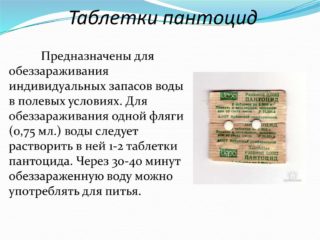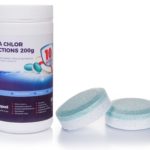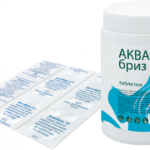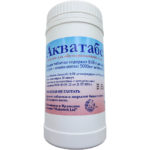The critical state of the ecological situation is fraught with danger for a modern person, especially when the question concerns the quality of drinking water, which is taken from natural open / closed sources directly. To bring it into a usable state, special tablets are used for water purification. The level of biohazard from the treated liquid is significantly reduced.
Purpose, scope of application of disinfecting tablets
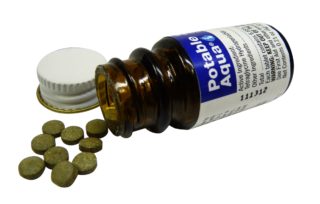
The main task of the preparations is to remove bacteria, viruses, and other biological contaminants from the aquatic environment. Basically, funds are divided into several types:
- iodine-containing;
- chlorine-containing;
- preparations based on silver ions.
Chlorine tablets are recognized as the fastest and most effective.
The use of disinfecting drugs is relevant in the following cases:
- Long hikes and the need to use drinking water from natural sources (rivers, lakes, streams). The quality of such a resource is highly questionable.
- The presence of wells in the country with low productivity with insufficient operation (seasonal). Standing water is an excellent breeding ground for bacteria.
- Villages located near military training grounds. Often, various tests are carried out at such bases, which heavily pollute the water layers of the region. As a result, the resource from local wells and wells is of poor quality.
- Dead animals caught in the source (birds, rodents, frogs, etc.). The body of a deceased individual poisons the water with cadaveric poisons, so the liquid requires mandatory disinfecting treatment.
The main requirements for the drugs used are good disinfection, high speed of work, and complete absence of sediment.
Types of pills and their principle of action
The most popular are the following types of tablets for disinfecting drinking water:
- Pantocid. Its main active ingredient is galazone. When acting in water, the drug does not give a tangible taste, color, odor. You can use tablets to treat wounds. The average cost of funds is 150 rubles. The drug is sold in blisters / packs of 40 pieces in one.
- Aquabriz. A domestic product based on chlorine. It is highly popular due to its efficiency and reasonable cost. The price for 10 tablets is about 30 rubles.
- Aquatabs. The drug is of Irish production. The main active ingredient is chlorine. It is believed that after the treatment of water with this drug, it is prohibited to store it for a long time. The price of a package of tablets is about 2,000 rubles.
- Aqua-chlorine. Another tool from the group of chlorine. Manufacturer - Russia. The package contains 400 tablets. The average price for a drug is 400 rubles. Aqua-chlorine is guaranteed to act against all types of bacteria.
- Potable Aqua. The drug is made in the USA based on iodine. Well established as an effective tool for hiking. Sold in polymer bottles of 50 pcs. The average price is 700 rubles.
The most popular means for disinfecting the walls of wells and the water in them are Ecobriz-Oxy and Septolit-DHTs.The tablets must be diluted in the recommended amount of clean water and treated with the mine ring solution. After 30 minutes, you can rinse off the product, pump out the water and start up the disinfected source.
Features of the use of drugs
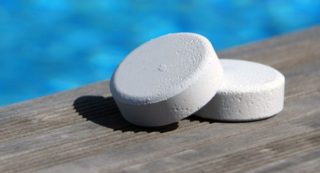
Despite the fact that the tablets are easy to use, there are important features to consider when handling liquids:
- It is advisable to filter the water before and after disinfection. In the first case, this will help remove large visible debris. In the second, remove the sediment.
- It is worth keeping the time recommended in the instructions when processing a liquid medium. This is usually 15-30 minutes. All components of the tablets must fully complete their effect.
- It is necessary to accurately observe the proportions of the drug per dose of liquid.
- After disinfection, it is advisable to additionally boil the water. It is not recommended to drink it raw.
- It is necessary to use chemical agents for disinfecting drinking water as a last resort, if other methods of liquid purification are not available.
- If children go hiking, it is better to support their body with probiotics. Chemicals can disrupt the digestive tract of a little tourist.
Do not use drugs that have expired. At least the effect from them will be zero. In the worst case, a disastrous result is possible - toxic poisoning.
Advantages and disadvantages of the method
The increased demand for tablets for drinking water treatment is formed due to the following advantages:
- The drug is lightweight, easy to hike, does not take up much space in a backpack. There is no need to carry heavy drinking water cans in the field.
- Short terms of disinfection. After 15 minutes, the water is ready for further use.
- The ability to disinfect liquid from any natural source.
- When using tablets, there is no need to apply additional methods of processing the resource.
- Lack of pungent taste and odor of water when treated with tablets.
The drugs also have a number of disadvantages:
- Inability to use for allergy sufferers. Chlorine, iodine or silver can provoke unexpected reactions from a weak body.
- Difficulty in treating water with a lot of contaminants.
- Chlorine and iodine-based preparations are considered conditionally toxic to the human body. Therefore, their frequent use is undesirable.
If tablets are used to treat well or well water, it is advisable to do a preliminary detailed analysis. Perhaps the composition of the liquid medium is also rich in other impurities that chlorine-containing tablets cannot cope with.

